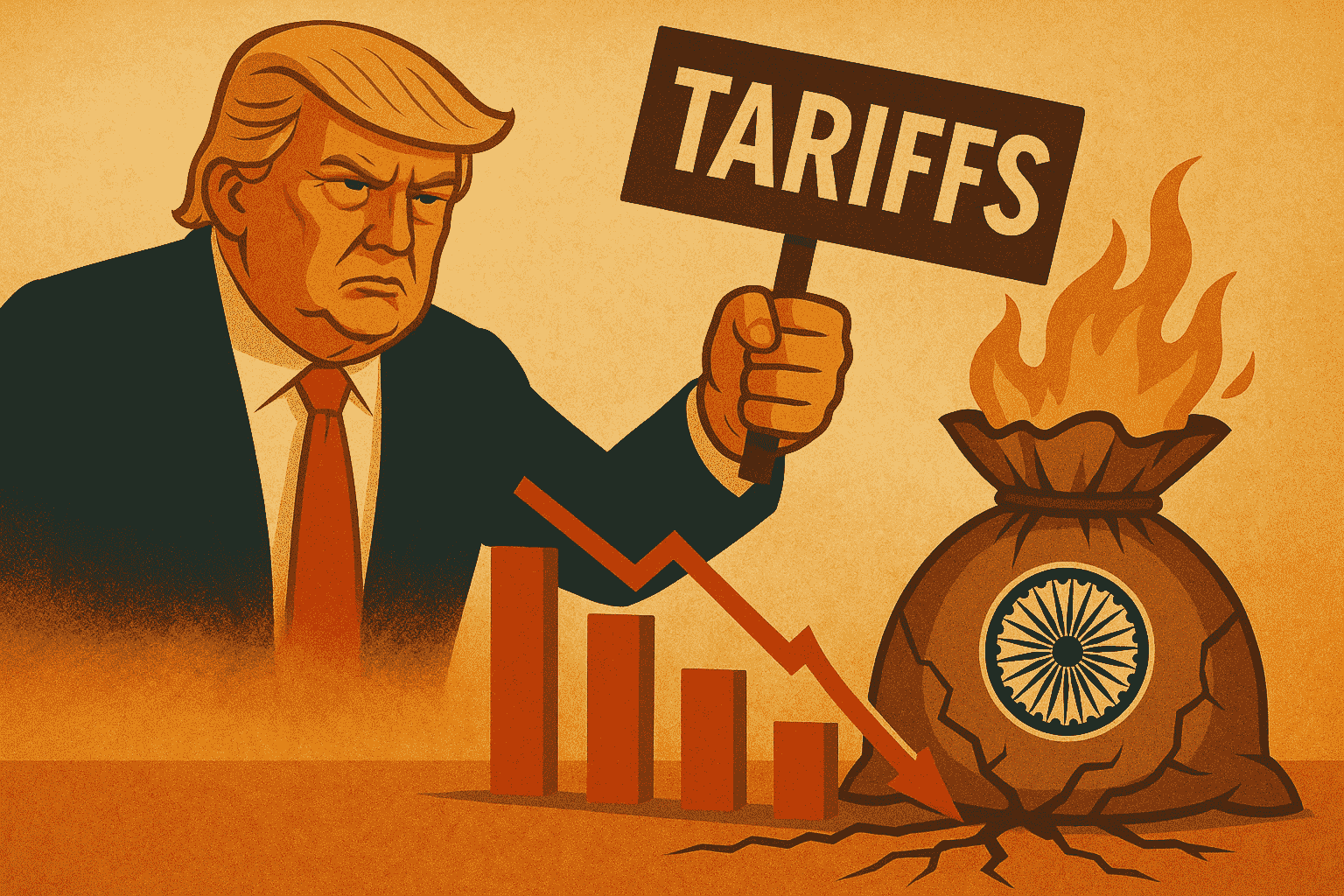What are Tariffs?
Tariffs are essentially taxes on goods crossing international borders, primarily imports. Countries use them to shield domestic industries, but this can trigger global economic repercussions. By increasing the cost of foreign goods, tariffs can reduce their demand. While some, like Donald Trump, anticipate a boost in domestic production due to higher tariffs, economists often disagree about these outcomes.
To what extent will the Indian economy suffer due to Donald Trump’s reciprocal tariffs?
Despite potential slight effects from US tariffs and global economic turbulence, Indian government officials are optimistic, projecting a 6.3-6.8% growth rate for FY26 if oil prices stay under $70/barrel. In contrast, private economists forecast a slightly lower 6.1% growth, citing the impact of Trump’s global tariffs.
On April 3rd, President Trump imposed a 26% tariff on Indian goods, significantly higher than those levied on other nations. This action, exceeding the 10% baseline for most countries, severely impacted India’s stock market, bilateral trade with the US, and overall economic health, creating a major strain in their trade relations. Despite being lower than tariffs other countries impose on the US, the move was seen as a substantial blow to India.
The Indian market reacted sharply and immediately following the overnight news of that day. The Indian market reacted sharply and immediately following the overnight news of that day. A greater than 500-points fall in the BSE Sensex at the start of trading instantly impacts the Nifty50 in the Indian stock market. Amid the ups and downs in the market, the Indian rupee also weakened against the US dollar, trading near Rs 85.69.
The 26 percent tariff anticipated for the Indian automotive industry, which currently accounts for about 3 percent of India’s total exports to the USA, is likely to lessen demand and crumble the competitive edge of Indian car exports in the US. This could trigger a ripple effect, leading to hiked production expenses, job losses, and disturbances within the supply chain. The Nifty IT sector suffered a loss of over 3 percent as Trump’s reciprocal tariffs intensified worries about a recession and decreased elective spending.
US tariffs on Indian machinery could hurt American businesses relying on Indian iron and steel, making their exports less competitive and hindering growth. Although India’s small trade surplus with the US limits the direct impact of these tariffs, they could still increase emerging market volatility. This situation, like the risk-off effect of tariffs, presents an opportunity for negotiating against retaliation. Generally, US protectionism negatively impacts the Indian stock market by increasing global risk aversion, leading FPIs to pull out of emerging markets like India for safer investments.
To reduce trade imbalances, India can bolster its presence in pharmaceuticals, electronics, and apparel. India’s relatively inward-focused economy has limited the impact of tariffs compared to more trade-dependent Asian nations.
Considering the US, tariffs would affect its consumers. India’s situations compared to other nations and the potential impact on its exports if US duties affect those countries’ GDP are important questions. Financially, such developments could improve market confidence and consumer spending.
To cushion the blow of tariffs, the Indian government should implement policies that lower business costs and streamline domestic processes, thereby strengthening local businesses’ resilience to external economic pressures.
Faced with US tariffs, the RBI lowered the repo rate by 25 basis points. While lower interest rates can boost real estate investment and related household spending, their impact on overall investment for capital formation is limited. Thus, interest rate cuts primarily stimulate consumption rather than significant capital formation.
Impact of Tariffs:
- Higher import duties, tariffs, on Indian merchandise could dampen their sales in the American market by making them (Indian commodities) less affordable.
- Facing a likely dip in demand from the USA, the garment and apparel industries, which rely heavily on exports, could experience job losses.
- Higher US duties on imported steel and aluminium will raise Indian automakers’ production costs for vehicles exported to the US. This could lead to higher prices in the American market, potentially decreasing demand for these Indian automobiles.
- The essential contribution of India’s gemstone and ornament industries to its exports to the United States is anticipated to suffer negative consequences.
- The export of dairy products such as specialty cheeses and whey protein concentrate might come across some challenges.
- Higher US tariffs on steel and aluminium imports will likely increase Indian automakers’ production costs for vehicles destined for the US. This could translate to higher prices for these Indian vehicles in the American market, potentially reducing their demand.
- Reduced agricultural exports to the U.S. threaten India’s agro-trade surplus with them.
- Analysts think India’s smaller export-to-GDP ratio might cushion the negative impact on its economic growth.
India’s Response and Strategies:
- Initially, India prioritized diplomacy over retaliation.
- India and the US governments are currently in trade talks to boost market penetration and lower trade barriers, with the aim of concluding a deal this year.
- India is actively pursuing new trade agreements and exploring different markets as a strategic response to the imposition of tariffs.
- To potentially lower reciprocal tariffs, India might increase imports from the U.S. and reduce its own tariffs on U.S. agricultural goods and electric vehicles.
- In sectors where India’s tariffs are less than those of competing countries, it could develop a comparative advantage.
- While confronting potential tariffs, crucial Indian exports to Trump’s US, notably pharmaceuticals, received an exemption, and information technology services avoided direct impact.
- The Indian stock market initially fell after tariffs were enforced due to investor worries but later regained some ground.
- The prior US president’s tariffs caused economic setbacks for some Indian sectors and raised concerns about slower growth, though the full long-term impact is still unclear. This impact will depend on tariff competitiveness, trade agreements, export diversification, and the strength of India’s domestic manufacturing.
Can India weather the storm of the global tariff war? An analysis of the situation is presented below:The Indian economy is significantly propelled by its powerful trade relationships with key export partners, notably the United States of America, the United Arab Emirates, and China. The India-USA bilateral trade in machinery, agriculture, iron and steel and automotive sectors has seen both advancements and setbacks recently. India strategically counters tariff hikes through diplomacy and trade deals, prioritizing concessions, US foreign-trade zones, domestic production, and WTO dispute resolution over immediate retaliation.
– Dr. Moharram Ansari, Assistant Professor
Department of Economics, Madhav University

